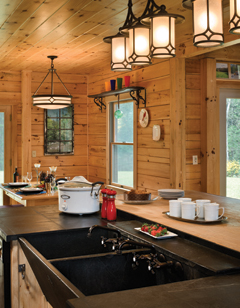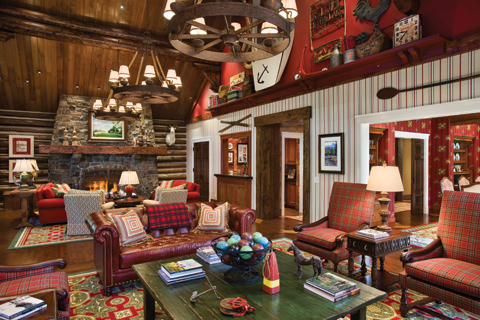The right lighting can make a world of difference in the look and feel of your home. As author James Thurber once said, “There are two kinds of light—the glow that illumines, and the glare that obscures.”
Many log and timber home producers handle lighting design in-house and are familiar with the unique lighting needs of log and timber frame homes. But to ensure your home is lit to maximize comfort, showcase design elements, and eliminate glare, you might want to consider hiring a lighting professional to help with the design. Professional lighting designers are up to date on the most innovative lighting solutions, and can help you determine the right approach for your family and home.
Choosing a Pro
Currently, there are no specific credentials required for lighting designers, though there are professional membership associations. The International Association of Lighting Designers (IALD) requires that its professional members have at least five years of experience in architectural lighting design but does not specify education requirements. “My degree is in architectural engineering with a specialty in illumination,” says Gregg Mackell, IALD, of 186 Lighting Design Group in Denver, Colorado. “It’s really important to talk to a lighting designer who is passionate about what they do, has a strong portfolio, and has worked on similar homes and has experience with log homes specifically.”
It’s a good idea to talk to your architect or builder about who they’ve worked with on other, similar projects that they would enthusiastically recommend. When the parties involved have worked together in the past, it often helps smooth the process.
Brighter Isn’t Always Better
“Most people who build homes wait until the electrician says it’s time to think about the lighting before they give it a thought, and by then it’s too late to get a good design without delaying the project,” says Mackell. It saves time and money to think about how you’ll be using the spaces in your home—not just today, but in the long term—to determine lighting needs. “I just got a call from a couple who had built a log home and didn’t put any thought into the lighting,” says Mackell. “They had been using it as a second home so they didn’t mind the inadequate lighting, but once they retired and moved in full time they realized they needed to address it.”

Coventry Log Homes/photo by Roger Wade Studio
A common mistake is to overcompensate for the darkness of logs by adding too much light, which is neither cost effective nor energy efficient—plus, an over-lit home can feel harsh. “Log homes have a special quality,” says Mackell. “You want to retain that warmth and coziness.” A better approach is to think in terms of different lighting needs in different spaces. For example, you’ll want task lighting in the kitchen, but softer light in the bedrooms, balancing function with aesthetics. “In my mind, I visualize the spaces and start from zero,” says Mackell. “I picture the space as being completely dark and go from there.”
Part of the Team
It’s the lighting designer’s job to work alongside the other professionals involved in building your home, from the log producer to the interior designer. That process starts after you have designed your home’s layout, but before the logs have been stacked. “If you get a lighting designer involved too early in the project, we have to react to a lot of changes that can drive up the final fee,” says Mackell. “There is a sweet spot on when to get a light pro in—when the furniture plan has been designed, walls are set, kitchen and bathroom plans have been finalized, that’s the perfect time for someone like me to jump in.”
Setting up a line of communication between the lighting pro and your log home producer is essential. “The communication with the log producer is so important, to coordinate with them while they still have the logs in their shop,” says Mackell. That way you can address details, like wall sconce elevations, in advance, rather than having to make changes after your home has been built.
A Smooth Process
Lighting designers use a process similar to that of an architect, from drafting plans to issuing construction documents. In an ideal situation, the lighting designer will continue to work with you through what Mackell calls “final aim.” This step is critical because it involves adjusting the aim of the lights once your house is built and ready to live in. “We use a lot of adjustable lights that can point in different directions and have different beam spreads and filters,” says Mackell. “We have to take that final step, otherwise it’s like having a Stradivarius that’s out of tune.”
Be sure to talk to both your log & timber home producer and lighting designer about the long-term costs and maintenance requirements of your lighting solutions. For example, if you have cathedral ceilings that are perfect to showcase a dramatic chandelier, be sure you use a light fixture that won’t need the bulbs replaced too frequently. Consider integrating a lighting control system rather than multiple switches and dimmers, both for better light control and for aesthetics. “If you have more than three switches on a wall it can be hard to remember what each one is for,” says Mackell. “That’s when it makes sense to use a lighting control system, and it pays to have someone who understands lighting controls involved.”
When your home is perfectly lit, you may be surprised by what you don’t notice. “You are not necessarily trying to get people to notice the light, but walk into the log home and see the architecture and the art and the decorative features and the comfort,” says Mackell. Working with a professional lighting designer will ensure your home’s light enhances, rather than detracts, from the natural beauty.

